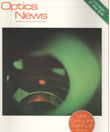
March, 1987 Issue
Feature Articles
Notions of order and chaos go back a long way. The Greeks held that all motion could be decomposed into "perfect" circular motions, and this belief led to the theory of planetary epicycles. We might phrase the Platonic ideal this way: all motion is quasiperiodic, meaning the Fourier transform of any coordinate consists of sharp spikes (Fig. 1). Poincaré near the turn of the century, was perhaps the first person to realize that there are (bounded) motions whose spectra do not have this form. Such systems have a broadband, continuous component in their spectra, as shown in Fig. 2.
by Peter W. Milonni, Jay R. Ackerhalt, and Mei-Li ShihEditor's note: This is the third of 11 monthly installments of lecture demonstrations on radiation exchange, by J.H. Taylor of Rhodes College in Memphis, Tenn. Next month's topic: Radiant emissivity.
by J. H. TaylorThere are times when the physical science side of OSA tends to forget about our members interested in vision. The same is true with standards, but we intend to give equal time this month.
by Robert E. ParksLaser cooling and electromagnetic trapping of atoms
The new field of laser control of atomic motion, spanning optics, statistical mechanics, and atomic physics, is developing at a very rapid rate. Its status was defined last year at a summer school organized by Stig Stenholm of the Research Institute for Theoretical Physics in Helsinki, Finland. About 80 scientists met to discuss the present and future of laser cooling and trapping of atoms. (This is a subject with a meager past—there were no laser cooling experiments before 1978.) The following report is both a brief review of the status of the field, based on the summer school, and a summary of more recent developments.
by Harold Metcalf

![Manual probe system with needles for test of semiconductor on silicon wafer. [A. Morozov / Getty]](https://opnmedia.blob.core.windows.net/$web/opn/media/images/articles/2025/1125/departments/202511-cover-web.jpg?ext=.jpg)
![Researcher Clara Saraceno in the lab. [Image by Carsten Behler Photography]](https://opnmedia.blob.core.windows.net/$web/opn/media/images/articles/2025/1025/departments/202510-cover-web.jpg?ext=.jpg)
